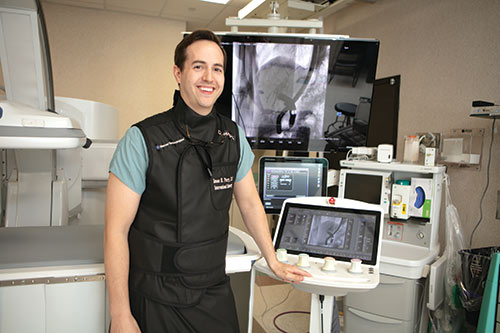Scoping Out the Future
Interventional gastroenterologists are taking endoscopic procedures into new territory.
The development of advanced endoscopic procedures, such as endoscopic ultrasound (EUS) and endoscopic retrograde cholangiopancreatography (ERCP) has come at a good time for patients in Savannah and the Low Country. These procedures help interventional endoscopists to diagnose and treat a wide range of gastrointestinal (GI) diseases, and the need for this kind of care is growing in this region.
“These procedures give us a really good understanding of what is occurring in both the lumen of the GI tract, or oftentimes, outside of it,” explains Isaac E. Perry, D.O., an interventional gastroenterologist at Gastroenterology Consultants of Savannah, P.C. “For example, I receive many referrals for pancreatic cysts and masses, and using a scope, I am able to better clarify what is occurring and if indicated, obtain a biopsy, all from within the GI tract.”

From a patient’s perspective, the experience is like a routine outpatient endoscopy. That’s when a gastroenterologist inserts a small, flexible tube, which contains a tiny video camera, into a patient’s mouth or rectum. It’s a minimally invasive procedure, without incisions, that allows physicians to visualize the digestive system and adjacent structures.
But advanced endoscopists like Dr. Perry can do even more. Large pseudocysts (fluid collections from pancreatitis), abscesses and even the gallbladder/bile duct can be drained by creating a connection between the GI tract and the target structure. Stents can be placed inside the GI tract due to a narrowing, whether that is from benign disease or cancer. In the event of a perforation or fistula where a hole is formed in the GI tract, Dr. Perry can suture, endoscopically, to seal off leaks, thus sparing patients an operation.
Inside The Pancreaticobiliary System
Bile is a fluid made by your liver. It helps your body digest food. The network of organs and ducts that create, store, and release bile is known as the biliary system. The bile delivered through the biliary tract not only breaks down and absorbs nutrients from your food, it also carries waste products to be disposed of through the intestines. Problems arise when bile becomes obstructed.
Unexplained weight loss, upper abdominal pain or jaundice, the yellowing of the skin and eyes, can indicate a problem such as a stone in the bile ducts, blockages, or strictures of the bile ducts, or even a tumor. Some patients will have a change in their urine and stool color. If these symptoms are present, Dr. Perry recommends talking with your primary care physician as soon as possible because an advanced procedure may be necessary.
If there is an issue inside the bile ducts, most patients will have had some type of imaging, such as a CT scan or MRI. Often this leads to a referral for an EUS or ERCP to evaluate the pancreaticobiliary structures. Dr. Perry utilizes instruments placed through the scope to address some of those issues. This could include breaking up and removing bile duct stones, addressing bile leaks, dilating strictures, retrieving a tissue sample for a biopsy, and placing a biliary stent. He also performs cholangioscopy, which is a scope within a scope. This procedure provides excellent visualization of the bile duct.
“The options we can offer patients all within the caliber of an endoscope is remarkable,” Dr. Perry says.
From Old to New
Dr. Perry is an interventional gastroenterologist, a subspecialist within gastroenterology that requires an advanced fellowship. This year-long fellowship is in addition to three years of internal medicine residency and three years of gastroenterology and hepatology fellowship. By completing this fellowship, he can perform novel procedures such as the endoscopic ultrasound-directed transgastric ERCP, or the EDGE procedure.
“The EDGE is one of my favorite procedures,” Dr. Perry says. “It’s needed when patients have altered anatomy that makes it impossible to do a traditional EUS or ERCP. This is the case for patients who have undergone gastric bypass surgery, for example.”
For the EDGE, Dr. Perry employs a technique using an endoscopic ultrasound to create new access between the patient’s old stomach and their new stomach, temporarily undoing their bypass in a way that can be restored later.
“This technique allows me to create a fistula using a stent, which depending on the urgency can be sutured in place. Through this new fistula I can accomplish an EUS/ERCP in the traditional sense,” he says.
Procedures such as the EDGE can help patients who are not appropriate candidates for surgery, or for those who do not desire another surgery or percutaneous approach. Dr. Perry collaborates with other specialists to make sure patients are receiving the most appropriate intervention for their condition.
“I work closely with many different surgical subspecialists as well as interventional radiology and oncology,” he says. “We work together as a team for some of these challenging cases. It’s a great partnership.”
Right Here
Dr. Perry is excited that these advanced procedures are available to patients in this region. He knows the difference it can make when new procedures are more accessible. It’s not only more convenient for the patient but can bring them peace of mind knowing they are in highly-trained and compassionate hands.
“We have the skill set and technology right here in Savannah,” he says. “You don’t have to stress about traveling for hours to be able to get this kind of care.”
Being able to offer new treatment options has been rewarding for Dr. Perry as well.
“I truly love coming to work,” he says. “It is gratifying to help patients along their healthcare journey, and I want to help them quickly and safely. I am highly motivated to help get patients in for advanced procedures, usually within a few days to a week. That’s what I would want for myself and my family members. Most of the time patients improve rather quickly following an advanced procedure and it is fulfilling to witness their success.”